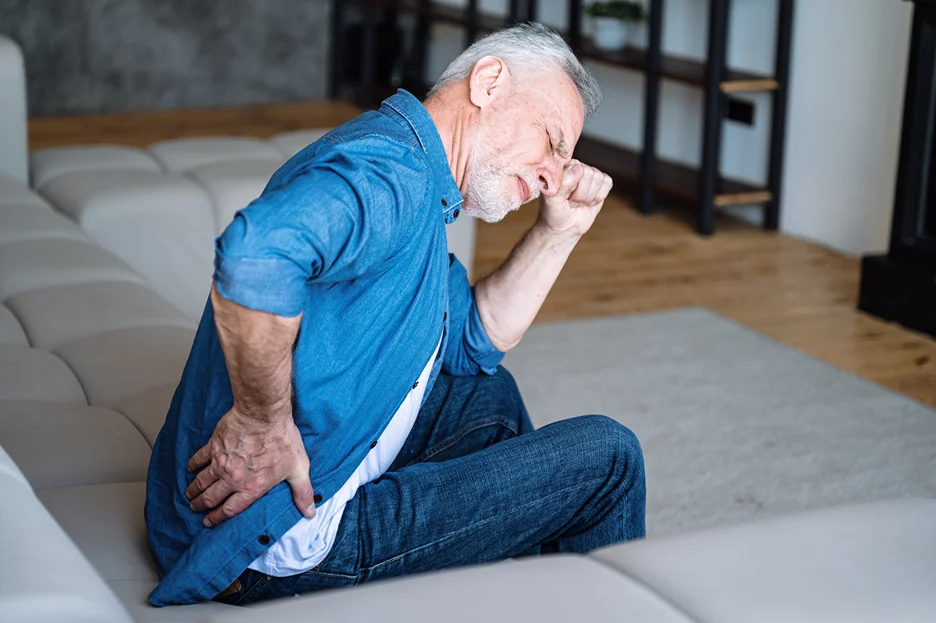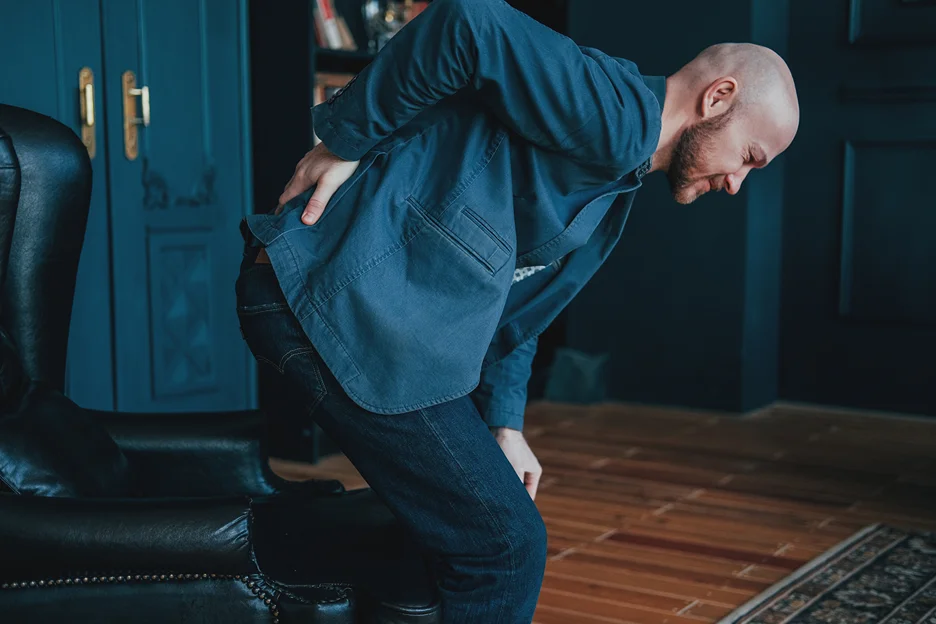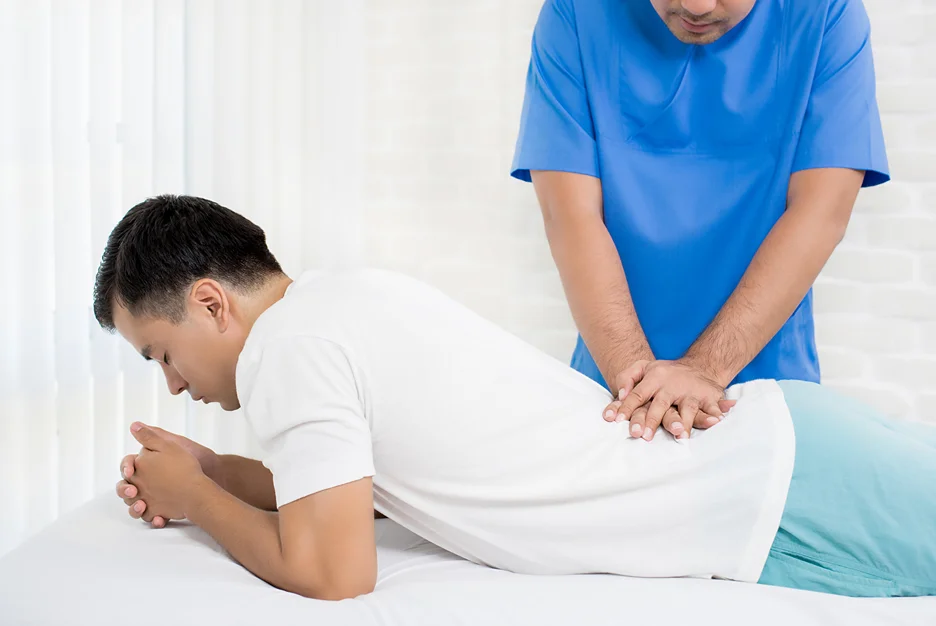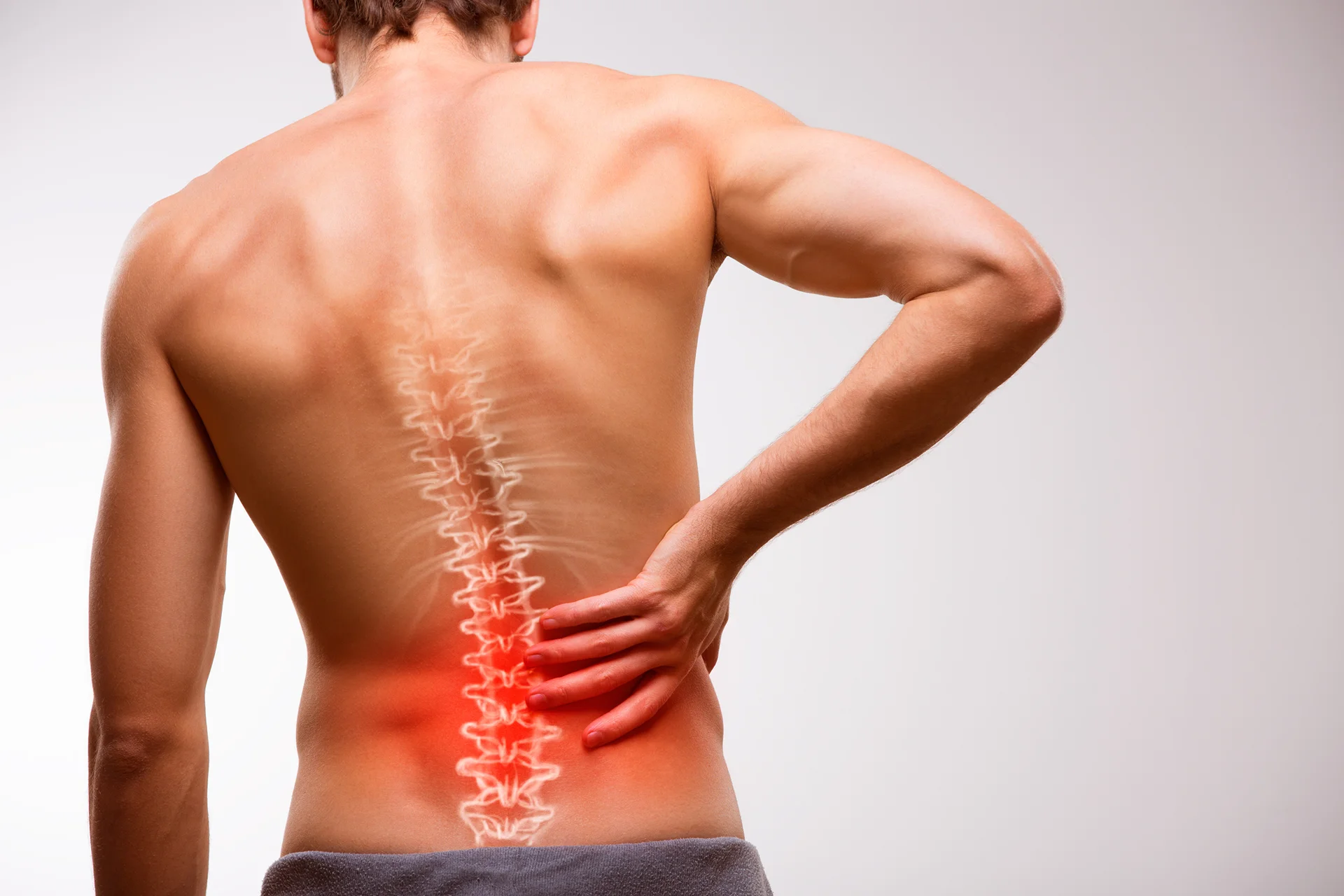If you think all back pain treatments are the same, think again. Discover what’s new in fighting chronic back aches.
Do you suffer from chronic, aching lower back pain that just won’t go away? Does it hurt to sit, bend, or lift objects? Have you tried various treatments and exercises without lasting relief?
If this sounds familiar, you may be one of the many adults unknowingly living with vertebrogenic low back pain – an underrecognized yet common cause of persistent spinal discomfort. Recent advances reveal this pain stems from inflammatory damage to the vertebral bones themselves.
Read on to learn what defines vertebrogenic back pain, how it’s diagnosed, key differences from other causes, and most importantly, what new targeted treatments now provide hope.
What Defines Vertebrogenic Low Back Pain?

Vertebrogenic low back pain has several characteristic symptoms according to our specialists at Kaly. Being aware of these hallmarks can help in identifying a vertebral source and seeking proper treatment.
Localized Pain
The pain stems from the lower back area rather than radiating to other areas like the upper back or neck. While it can spread into the legs as sciatica, the central location is the lower spine.
Constant, Chronic Ache
Patients often describe the pain as a constant, chronic ache. It may fluctuate in intensity but remains present continuously to some degree. This differs from the intermittent, short-lived pain of a muscle sprain.
Stiffness and Reduced Mobility
Many patients notice stiffness and restricted range of motion in the lower back. Bending and twisting become difficult. The natural curvature of the spine can be reduced.
Pain Triggers
Typical actions like bending, lifting objects, walking, or standing for extended periods commonly aggravate the pain. The vertebrae are further compressed and irritated.
Neurological Symptoms
Numbness, tingling, or weakness in the legs and feet arises when nerve roots exiting the spine become impinged or inflamed. This neurologic dysfunction prompts diagnosis.
Tired of “treating” back pain without long-term relief? Schedule a thorough exam with Kaly physical therapists today!
How Is Vertebrogenic Low Back Pain Diagnosed?
Diagnosing vertebrogenic back pain involves several approaches per Kaly experts:
- Medical history and physical examination assessing range of motion and locating the pain origin.
- Imaging tests like X-rays, CT scans, and MRIs to visualize spinal anatomy in detail.
- Electrodiagnostic testing including EMG studies evaluating nerve function.
- Diagnostic injections into the epidural space, facet joints, or nerve roots to pinpoint pain generators.
- Bloodwork to rule out inflammatory conditions and infections.
- Potential referral to spine specialists like orthopedic surgeons or neurosurgeons for complex cases.
How Does Vertebrogenic Low Back Pain Differ From Other Types of Back Pain?
Vertebrogenic low back pain in adults is caused by age-related spinal issues like degenerative disc disease, spinal stenosis, vertebral compression fractures, segmental instability, and in rare cases, spinal infections or tumors.
- Degenerative Disc Disease
As intervertebral discs age, they tend to dry out, shrink, and develop small tears or protrusions. This reduces their ability to cushion the vertebrae during movement. Irritation of nearby nerve roots can also occur. Degenerative changes are often visible in imaging studies.
- Spinal Stenosis
Wear and tear of the spine can lead to the narrowing of the spinal canal or neural foramen. This compresses the spinal cord and nerve roots passing through these openings, resulting in neurological complaints.
- Vertebral Compression Fractures
Fractures of the vertebral bodies often occur due to osteoporosis. Traumatic injury can also cause vertebral fractures. The altered shape and position of fractured vertebrae impacts spinal biomechanics and commonly leads to pain.
- Segmental Instability
Factors like disc degeneration can result in improper alignment or excessive motion between two vertebrae. This instability irritates surrounding tissues. Spondylolisthesis, or slippage of one vertebra forward over another, is a frequent result.
Red Flag Symptoms
Rarer causes like spinal infections, inflammatory conditions, and tumors can produce vertebrogenic pain as well. These require prompt diagnosis and management.
What Causes Vertebrogenic Low Back Pain in Adults?

Vertebrogenic low back pain in adults is caused by progressive inflammation and structural damage to the vertebral endplates over time, which can irritate pain-sensing nerves inside the vertebrae called basivertebral nerves.
Endplate Inflammation
Inflammation develops in the vertebral endplates as bony tissue breaks down over time. This can spark pain signals due to irritation of nerves inside the vertebral bone structure known as basivertebral nerves.
Activities That Increase Pain
Bending forward, prolonged sitting, and physical exertion often worsen pain by placing more pressure on sensitive endplates. Modifying these activities can provide relief.
Contributing Factors
Aging, genetics, obesity, smoking, repetitive spinal loading from heavy lifting or sports, and family history can contribute to endplate degeneration over the years. However, even young adults may develop vertebrogenic back pain.
Detecting Changes via Imaging
MRI scans can reveal inflammatory vertebral endplate changes called Modic changes. Type 1 Modic changes strongly correlate with more severe vertebrogenic pain. Imaging helps confirm the source.
What Are the Symptoms of Vertebrogenic Low Back Pain?
The symptoms of vertebrogenic low back pain include centralized lower back pain focused in the spine’s midline that worsens with bending, lifting, prolonged sitting, and standing, along with referred pain in the buttocks and hips but not true sciatica.
Centralized Lower Back Pain
- Patients experience pain concentrated in the midline of the lower back region. This reflects the central spinal location of the inflamed vertebral endplates.
- The pain does not radiate widely or extend into the legs as with sciatic nerve irritation. It remains focused on the lower spine.
Pain Aggravators
- Bending forward, lifting, prolonged sitting, and standing often worsen the dull, aching pain. These motions increase mechanical stress on inflamed endplates.
- While constant, the baseline pain intensifies with provocative movements and postures. Patients link the pain to specific aggravators.
Referred Pain Patterns
- While centered on the lower spine, vertebrogenic pain can refer or radiate into nearby areas like the buttocks and hips.
- This occurs from inflammation spreading to adjacent nerve roots. However, true sciatica is less common.
Can Vertebrogenic Low Back Pain Be a Chronic Condition?
According to Kaly specialists, vertebrogenic low back pain often manifests as a chronic, ongoing condition rather than intermittent acute episodes.
Patients describe a baseline constant ache in the lower back that intensifies with provocative motions like sitting, bending forward, or physical exertion.
While the pain stems from the central spine, it can radiate into the hips and buttocks from inflammation spreading to adjacent nerve roots. However, true sciatica extending below the knees is uncommon.
Researchers now believe vertebrogenic pain may account for a significant portion of cases previously categorized as chronic back pain from degenerative disc disease, spondylosis, or nonspecific causes.
How to Differentiate Vertebrogenic Low Back Pain From Sciatica?
Vertebrogenic low back pain causes centralized chronic spinal pain worsened by activity with referral into the buttocks or hips, while sciatica refers pain and numbness from the back down the leg in the sciatic nerve distribution and is often traced to a compressive lesion like a herniated disc.
| Important Factors | Vertebrogenic Low Back Pain | Sciatica |
| Causes | – Inflammation, damage, or degeneration of the vertebral endplates and basivertebral nerves inside the vertebral bones | – Compression of the sciatic nerve roots as they exit the spine, often from a herniated disc, bone spur, spinal stenosis, etc. |
| Symptoms | – Chronic lower back pain, often centralized in the midline- Pain worsens with sitting, bending, activity- Can refer pain in buttocks/hips | – Pain, numbness, or tingling extending down the sciatic nerve path, typically down one leg to the foot- Can range from mild to severe- Leg weakness or muscle atrophy can occur |
| Diagnosis | – Chronic localized low back pain- Modic changes on MRI indicating vertebral endplate damage | – Leg symptoms in the sciatic distribution- Imaging showing nerve root compression (e.g. herniated disc) |
| Treatment | – Medications, exercise, injections- Basivertebral nerve ablation targets the source | – Conservative treatment (rest, PT) – Epidural steroid injections, surgery (e.g. discectomy) for severe sciatica with defined compressive cause |
What Treatments Are Available for Vertebrogenic Low Back Pain?

According to Kaly specialists, initial conservative therapy for vertebrogenic pain includes medications like NSAIDs and muscle relaxants, along with physical therapy. However, response rates to these standard treatments tend to be low for this specific pain generator.
More advanced, targeted options include:
- Basivertebral Nerve Ablation (BVNA): This minimally invasive procedure uses heat or chemical ablation to denervate the basivertebral nerve transmitting pain signals from the inflamed vertebral endplates.
Multiple studies confirm that BVNA provides significant and sustained pain relief and functional improvement in patients with chronic vertebrogenic back pain refractory to other conservative treatments. It is considered the most consistent approach for this particular diagnosis.
- Intracept Procedure: A similar radiofrequency ablation targeting the basivertebral nerve. Clinical trials show over 50% reductions in disability and pain scores at 2 years for vertebrogenic low back pain treated with the Intracept procedure after failing conservative therapy.
- Spinal Fusion: This surgery is generally reserved for cases involving true spinal instability or leg pain in addition to axial spine pain unresponsive to other interventions. It carries more risks than minimally invasive ablative options.
What Exercises Are Recommended for Vertebrogenic Low Back Pain?
The right exercises can provide stability, build endurance, and prevent flare-ups without aggravating vertebrogenic back pain. A customized program works best based on our experience.
General Stretching and Aerobic Exercise
Stretches like knee-to-chest pulls, cat-cow pose, and lower back rotations improve flexibility and spinal mobility. Low-impact cardio like walking, swimming, or cycling takes pressure off the back.
These aerobic and general conditioning exercises are good starter activities that can be maintained long-term. Water workouts like swimming are ideal early on when pain limits other exercises.
Targeted Strength Training
As tolerated, focused muscle strengthening provides added support. Examples include bridges, bird dogs, deadlifts with proper form, and lunge stretches to train back extensors, core, pelvic floor, and legs.
Avoid exercises like sit-ups or leg lifts initially, as these may overload sensitive tissues. Adjust activities based on pain responses. Seeking guidance from a physical therapist can be very helpful.
Tailored, Progressive Programs
The aim is building endurance over time with a comprehensive program tailored to the individual. This allows the back to better withstand daily stresses and prevent future vertebrogenic flare-ups.
A balanced regimen of stretching, aerobics, and targeted training works best. The level and types of exercise should be adjusted periodically as the back strengthens.
Are There Any Home Remedies for Vertebrogenic Low Back Pain?
- Cold compresses or ice packs can reduce inflammation around damaged vertebral endplates and numb pain signals temporarily.
- Heat therapy increases circulation to the affected area and relaxes muscle spasms that can occur.
- Massage releases muscle tension in the back and improves mobility. Increased blood flow may also help.
- Topical ointments containing lidocaine, capsaicin or other analgesics can provide superficial pain relief by blocking pain signal transmission.
- Targeted exercise strengthens the core and back muscles to better support the spine and reduce strain on the damaged endplates. Improved flexibility through stretches can help prevent further damage.
- Complementary therapies like acupuncture may activate natural pain-relieving endorphins and reduce muscle spasms to improve back mobility.
What Lifestyle Changes Can Improve Vertebrogenic Low Back Pain?
Lifestyle changes like losing excess weight, anti-inflammatory diet, aerobic exercise, core strengthening, ergonomic adjustments, stress management, proper sleep hygiene, and smoking cessation together provide a multifaceted approach to reducing inflammation, improving muscle support, and alleviating mechanical strain on the spine to ease vertebrogenic pain.
- Diet – Eating anti-inflammatory foods like fruits, vegetables, and omega-3 fatty fish can reduce inflammation contributing to vertebrogenic pain. Avoiding processed and sugary foods is also beneficial.
- Weight Loss – Losing even a modest 5-10% of excess body weight reduces mechanical stress on the spine and alleviates compressive forces on sensitive vertebral endplates.
- Exercise – Low-impact aerobic activity and core/back strengthening exercises improve flexibility, posture, and muscle support for the spine. This reduces strain and symptoms. Exercise also facilitates weight loss.
- Posture/Ergonomics – Making ergonomic adjustments to avoid poor posture and mechanical strain is important. Use lumbar supports and maintain good posture during daily activities. Modify lifting techniques to avoid excess spinal loading.
- Stress Management – Psychological factors like stress and poor coping impact perceived pain levels. Relaxation practices like yoga, meditation, or cognitive behavioral therapy can be helpful.
- Sleep – Getting adequate, high-quality sleep allows tissues to heal and restore. Poor sleep exacerbates pain sensitivity. Prioritizing good sleep hygiene is beneficial.
- Smoking Cessation – Quitting smoking can slow degenerative processes in the spine that contribute to vertebrogenic pain over time.
Are There Any Support Groups for Vertebrogenic Low Back Pain?
Currently, there are no specific support groups for vertebrogenic low back pain, which is an emerging diagnosis, but general chronic back pain groups can provide peer support and camaraderie; targeted vertebrogenic support communities may develop over time as this condition gains wider recognition.
General Chronic Back Pain Support
- Online forums like SpineUniverse and Lower Back Pain Answers provide peer support and let people share experiences about chronic back pain.
- Organizations like the American Chronic Pain Association and Pain Connection run in-person and virtual support groups for general chronic back issues.
Limited Vertebrogenic-Specific Support Currently
- No support groups specifically dedicated to vertebrogenic pain were found. This is likely because it is an emerging diagnosis.
- General chronic back pain support groups can provide some camaraderie. But the ability to discuss vertebrogenic-specific concerns may be more limited.
Outlook for the Future
- As vertebrogenic pain gains wider recognition, specific support communities may emerge to address this condition.
- For now, broader chronic back pain groups supplement professional treatment and provide a venue to connect with others experiencing ongoing spinal issues.
- Online forums allow accessing peer support more easily. Connecting with others dealing with chronic pain helps many patients feel less alone.
What Is the Prognosis for Vertebrogenic Low Back Pain?

The prognosis and treatment options for vertebrogenic pain have improved considerably in recent years with the development of basivertebral nerve (BVN) ablation.
Multiple studies show BVN ablation provides significant and durable pain relief for most patients with vertebrogenic low back pain refractory to conservative measures:
- In one study, BVN ablation led to a mean 30-point reduction in disability scores and a 4-point decrease in pain scores at 3 months post-treatment.
- At 2 years post-BVN ablation, 75% of patients were found to be “responders” based on achieving clinically meaningful improvements in disability and pain scores according to the data from this study.
- In a pooled analysis, patients maintained significant pain and disability improvements at a mean of over 6 years after BVN ablation, with 75% continuing to meet responder criteria at 5 years.
What Are Common Misconceptions About Vertebrogenic Low Back Pain?
- That it is primarily caused by injuries or heavy lifting. While those can contribute, research shows sedentary lifestyles, poor posture, obesity, and genetic factors also play major roles.
- That bed rest will make it better. Evidence suggests prolonged bed rest beyond 1-2 days is actually counterproductive for recovery. Staying lightly active with low-impact exercise is recommended.
- That spinal manipulation is the best treatment. Studies found targeted exercise more effective for long-term pain relief than manipulation alone.
- That inflammation drives chronic pain. While present acutely, most persistent vertebrogenic pain is mechanical in nature. Mechanical treatments like posture training tend to work better long-term.
- That spinal arthritis on imaging directly causes pain. These age-related degenerative findings are often asymptomatic. Imaging frequently does not correlate well with symptoms.
- That surgery based solely on imaging will help. It is often unsuccessful since many people have spine changes without pain. Surgery should address specific diagnosed pathologies, not just imaging abnormalities.
Can Vertebrogenic Low Back Pain Lead to Other Health Issues?
Untreated vertebrogenic pain can lead to worsening spinal damage, chronic neuropathic pain, muscle atrophy, depression/anxiety, and reduced quality of life; early diagnosis and treatment help prevent these secondary effects and long-term health impacts.
- Unresolved inflammatory Modic changes seen on MRI can progressively damage spinal structures over time, leading to worsening pain and disability if left untreated.
- Fatty conversion of the vertebral bone marrow from reduced blood flow (Modic type 2 changes) may impair the spine’s natural healing abilities and increase vulnerability to further injury. This could hasten degenerative processes.
- Sensitized nerves within damaged endplates lower the threshold for perceiving pain signals, which can cause chronic neuropathic pain that is difficult to treat.
- Prolonged vertebrogenic pain often leads to physical deconditioning and muscle atrophy from disuse and avoidance of activity. This can impede rehabilitation efforts.
- Like any chronic pain condition, persistent vertebrogenic pain is associated with depression, anxiety, sleep disruption, and reduced quality of life. The psychological burden should not be underestimated.
- There is evidence linking vertebrogenic changes on MRI (Modic changes) to nonspecific low back pain and disability.
Don’t accept back pain as “just part of aging.” Kaly’s advanced search engine will match you with the most suitable specialist for your specific needs. Begin searching now!
FAQs
Can physiotherapy help with vertebrogenic low back pain?
Yes, physiotherapy including low-frequency electro- and magnet therapy, therapeutic back massage, and therapeutic exercise can provide relief for vertebrogenic low back pain.
Is surgery ever required for vertebrogenic low back pain?
Surgery like spinal fusion may be required for vertebrogenic low back pain if conservative treatments like medications, physical therapy, and injections fail and there is no spinal instability or leg pain.
Can chiropractic treatment help vertebrogenic low back pain?
Yes, chiropractic treatment including spinal manipulation, exercise advice, and self-care recommendations can help relieve pain and improve function in people with vertebrogenic low back pain.
